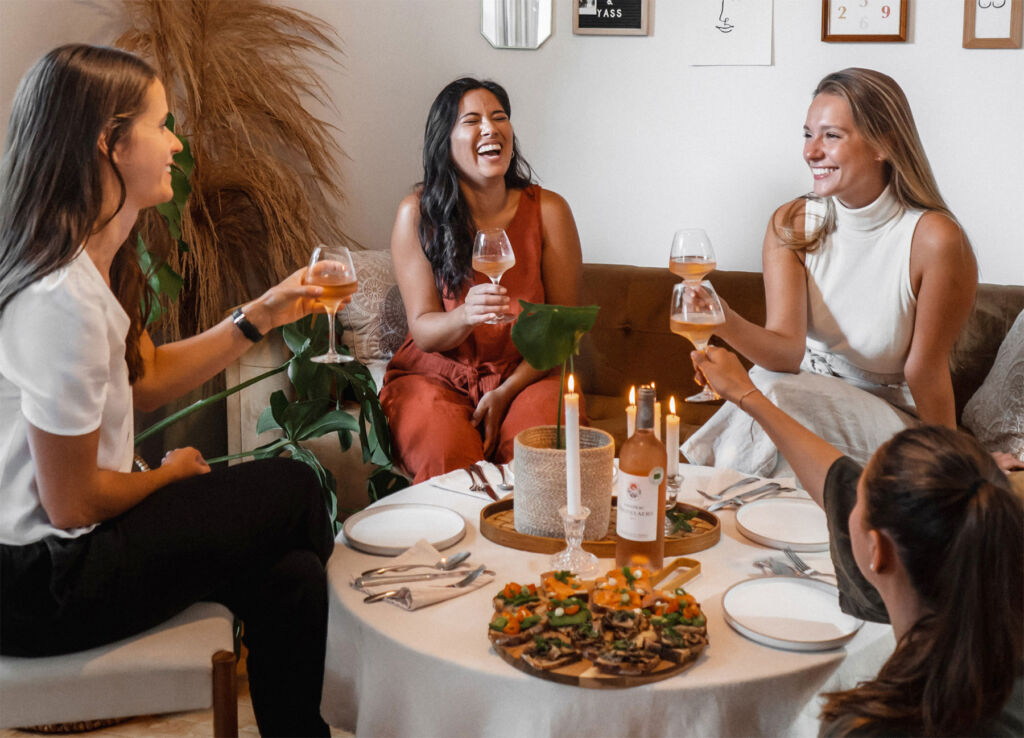

At this time of year, we gather to feast with family and friends, but when it comes to wine, one style always gets overlooked. Helena Nicklin explains why she is reclaiming rosé as the great, all-rounder wine to serve at the festive table.
I say it every year to my family and friends, and this year, I’ll say it in print: don’t forget your pink wines at Christmas. We tend to reach for the rich whites and reds when we sit down to eat, knowing that there’s no perfect match for the myriad flavours and textures presented to us on the plate. Next, come sticky Ports and Sauternes with the cheeses and puddings, so by the time the meal has finished, we are totally ready to snooze.
Now my siblings and I have small children, and we are blessed to spend many Christmasses together, snoozing is never an option. We have moved the main meal to a late lunch, but even without the delightful squeals and demands of sugar-crazed kids fighting over new toys, there’s no fun in having a thick, red wine head so early in the day.


Reliability
You may have noticed a surge in popularity over the last few years – lockdown especially – for the Provençal style of pink wine. I believe that this was for many reasons, the most important of which has been reliability. Wine drinkers have realised that in a sea of pink wine from the lightest to the darkest, you are never quite sure what you are going to get. Pale, Zinfandel blush from California can be immensely sweet, as can some dark rosés that are almost red. Then you’ll find another that is dark, meaty, and dry and throw your hands in the air, reaching for a Sauvignon Blanc instead.
A huge lockdown trend in booze saw us spending a little more on our wine as we couldn’t go out and wanted a bit of affordable luxury while we were stuck at home over the summer. We saw a pretty, pale pink at the right price point, and we fell in love, realising quickly that pale, Provençal rosé is one of the only styles of pink worldwide that will be reliably dry and saline, with subtle fruit flavours and a gorgeous, ballet slipper hue. This is not to say that all Provence rosé is the same, however. Hell no. And this is the next phase of our learning…


Not all Provençal rosé is the same
The next stage in the world’s love affair with Provence will be discovering that the styles vary according to the areas where the wine is produced. Look for Côtes de Provence on the label, and you’ll get a classic style that’s crisp and aromatic with notes of blossom and herbs, fresh citrus (think pomelo) and a subtle splash of tropical fruit on the palate. 90 per cent of Provence pink comes from this appellation, which takes in five sub-areas, each offering super subtle differences. These are Côtes de Provence Fréjus, La Londe, Pierrefeu, Sainte Victoire and Notre-Dame des Anges.
Also worth noting are the two other main production areas that you will find on the labels, though they are considerably smaller: Côteaux d’Aix-en-Provence and Côteaux Varois en Provence. If you love the Provence style but want a particularly fruity, mineral style, pick up a wine from Côteaux d’Aix-en-Provence.
Coteaux Varois, on the other hand, will give you a punchier, fuller-bodied pink with more fleshy notes of white and red fruit. Other, much smaller appellations exist within Provence too, such as Bandol or Pierrevert. Again, all these have that signature pale, saline, dry profile but with their own nuances brought into the glass by different soil profiles, altitudes and locations inland or on the coast.
We must not forget as well that not all quality levels are the same. While the price can quite often determine where the wine sits on the scale, the lofty ‘Cru Classé’ status exists in Provence and is held by just 18 estates and Châteaux. It is a title granted by the National Institute of Origin and Quality (INAO) to reward techniques, quality traditions and knowledge as well as the land itself.
These 18 are Domaine du Jas d’Esclans at La Motte, Château Sainte Roseline in Les Arcs sur Argens, Château Roubine, in Lorgues, Château de Saint Martin and Château de Selle in Taradeau, Domaine de Saint Maur in Cogolin, Château de Brégançon and Domaine du Noyer in Bormes les Mimosas, Domaine de la Croix in La Croix-Valmer, Château Minuty in Gassin, Château du Galoupet and Le Clos Mireille in La Londe les Maures, Château de Mauvanne at Salins d’Hyères, Domaine de l’Aumérade and Domaine de la Clapière in Hyères, Le Clos Cibonne in Le Pradet and finally, Domaine de Rimauresq in Pignans.
Gastronomic Provençal rosé
Perhaps the most exciting movement coming out of Provence is the production of more gastronomic styles of rosé wine. It’s rare to visit a wine producer there these days and taste one simple pink.
What you’ll usually find instead is at least two (and often more), rosé wines, all made for different occasions. Still always pale, fresh and dry, you’ll find some crisper styles that work perfectly as an apéritif on the beach or in the snow après-ski, but increasingly, you’ll also find weightier, more complex, rounder rosés with a delightfully creamy texture.
Some vineyards are suited better to these styles of wines than others, but the difference really comes in the way that these wines are made. Ageing in older wooden barrels, for example, allows for a micro-oxygen exchange that helps give the wine a creamier texture without making it taste oaky. Allowing the wine to rest on its lees (dead yeast cells left after fermentation) or be stirred with the lees also gives weight, texture and complexity to the wine as well as a fleshier note.
Versatility
It’s these sorts of gastronomic wines that offer incredible versatility when it comes to pairing them with food. They are the wines I choose to drink on the slopes with a fondue or with our main festive meal as they cover salads, salmon and prawn cocktail-style dishes like a dream, and then we can trade even further up to bolder, gastronomic styles that provide an incredibly refreshing pairing for the main event, complete with bread sauce, pigs in blankets, roasties, veg and red cabbage – the lot.
Nothing fights or competes with gastronomic rosé; it’s one of those matches that holds its own quietly and confidently and won’t make you want to fall asleep as soon as you’ve scraped the last bit of cheese from your plate. On that note, a gastro rosé from Provence (gastrosé?) is a surprise hit with a gooey Camembert and crackers. That and sweet chilli crisps. I’ve done my research.
Want to try some top-notch Provençal pinks this winter? Here are some of my favourite wines tasted this year:
Côtes de Provence Rosé
- Mirabeau Classic Provence Rosé – £12.99 Waitrose, Ocado (currently on offer)
Côtes de Provence La Londe
- Pas du Cerf ‘Audace’ Grand Cuvée 2021 – £19.99 from Cheers Wine Merchants
Côteaux d’Aix-en-Provence
- Château La Coste, Grand Vin Rosé 2021 – £21 from Wanderlust Wines
Côteaux Varois en Provence
- Château de l’Escarelle ‘Les deux anges’ 2021- £16.50 from Noble Green Wines
- Chateau Bellini 2021 – £19.99 from Hard To Find Wines
Gastronomic Rosé
- Domaine Mirabeau La Réserve Rosé 2021 – £25.99 from Butlers Wine Cellar
Iconic, Gastro Provence Rosé
- Étoile by Domaines Ott 2020 – £230 from Millesima
Garrus by Chateau d’Esclans 2020 – £99.99 from Majestic (mix 6 price)
In addition to contributing articles to Luxurious Magazine, Helena Nicklin is an award-winning broadcaster, wine consultant, drinks influencer and judge for various international wine and spirits awards. You can find her on social media @HelenaSips and as one of The Three Drinkers on Amazon Prime.
Read more wine guides, reviews and features here.
